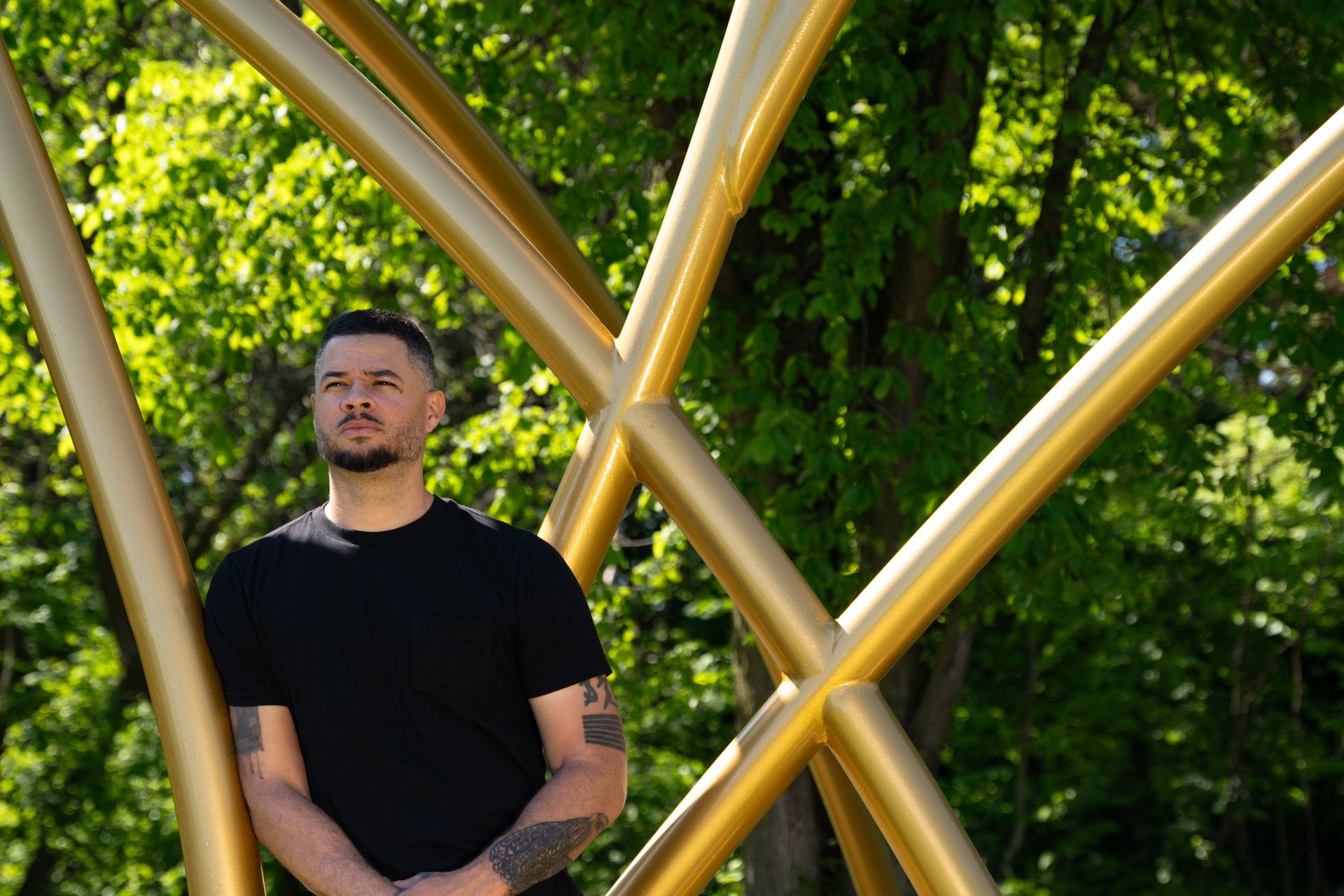On a recent day in May, the smell of gasoline and exhaust wafted through the air in East Canfield, Detroit, where artist Jordan Weber was putting the final touches on his public installation, Detroit Remediation Forest (DRF) (2024). Heavy and noxious, the air was the impetus for Weber’s project. Like neighbouring areas, East Canfield is being contaminated by the massive car manufacturing Stellantis-Mack Assembly Plant. Commissioned by the non-profit Sidewalk Detroit, Weber’s installation seeks to clean the polluted environment with air-purifying plants and arm residents with knowledge by monitoring and displaying air quality levels.
“DRF was conceived in response to the environmental racism prevalent in Detroit and it speaks to Sidewalk’s core mission of advancing spatial equity through the lens of community vision and restorative power of public art,” says Ryan Myers-Johnson, director and founder of Sidewalk Detroit.
This year, the American Lung Association named Detroit one of the worst cities in the United States for air pollution. The sprawling Stellantis plant is exacerbating East Canfield’s issues. The complex covers over 178 acres, bringing trucks and thousands of cars for employees through East Canfield each day, leaving its predominantly Black residents with increased health risks. Stellantis has been fined at least eight times for violating air quality standards since the Mack plant opened in 2021.

Jordan Weber's permanent installation New Forest, Ancient Thrones (2024) crowns the entryway to the Detroit Remediation Forest in East Canfield Art Park, East Canfield Village. Commissioned by Sidewalk
Detroit and created in collaboration with Canfield Consortium. Photo by Noah Elliott Morrison.
In a statement, a spokesperson for Stellantis said the company "finalised a settlement with the Michigan Department of Environment, Great Lakes and Energy Air Quality Division to resolve ducting and odour issues" at the plant in 2022. Since then, the department "has conducted inspections following a few odour complaints and has not confirmed a nuisance odour. The company continues to monitor for odours daily to confirm the new system is addressing this concern and also has not detected any nuisance odours". The spokesperson added that in 2019 Stellantis "established a $1.8m home repair grant fund that provided a $15,000 grant per interested homeowner for home repair", prioritising owner-occupied homes near the plant.
The assembly plant complex itself was built in 1916 by the Michigan Stamping Company, displacing thousands of families who had lived there for generations, and was expanded by new owners over the years, displacing additional residents. Like so many neighbourhoods in Detroit, East Canfield has faced decades of hardships in addition to air pollution, including foreclosures, flooding and population decline, leaving buildings abandoned and lots overgrown.
“Sidewalk Detroit and I talked a lot about legacy and holding space for Black land, landscapes and culture,” Weber says. “DRF is about place-keeping, not place-making. One of the things I want to do is bring funds to help this place-making, and there are a lot of funds in art.”
Weber’s installation expands an existing green space with additional areas for community gathering and air-purifying plants, such as conifer trees that collect particulate matter, as well as a gold, aluminium sculpture in the shape of a double crown. DRF was created with Canfield Consortium, one of the grassroots organisations reviving the community. Founded by East Canfield residents, sisters Kim and Rhonda Theus, the non-profit works to restore the neighbourhood’s decaying and abandoned spaces.

Portrait of Jordan Weber in front of his permanent installation New Forest, Ancient Thrones (2024), which crowns the entryway to the Detroit Remediation Forest in East Canfield Art Park, East Canfield Village. Commissioned by Sidewalk Detroit and created in collaboration with Canfield Consortium. Photo by Jasmine Sumlin.
“Air quality is an issue many of us wanted to ignore,” says Kim. “With the Canadian wildfires last year, it became clear we need to address it. That’s why we were so happy with Jordan’s piece. Art can make challenging issues more palatable. It’s an iron fist in a velvet glove.”
Weber paid homage to Rhonda and Kim in the sculptural element of DRF with its double-crown design based on Queen Idia of Benin and Queen Ranavalona III of Madagascar, likening the work the sisters have been doing in Detroit with that of the queens resisting foreign powers.
“Queen Ranavalona III resonated with me in particular,” says Kim. “She was exiled for her attempts to fight colonisers, which reminded me of what’s happening in Detroit with the housing crisis and people losing their homes to unjust foreclosures. At a time, we had the highest Black home ownership in the country, but now we’re a city of renters.”
The sculpture, New Forest, Ancient Thrones, holds the air quality sensors that change colour in response to the monitoring system. Also accessible via an application, the information helps educate the public and gives them tools to advocate for their health. “We’re not asking the auto manufacturer to go away, we want them to own up to the issues and have a conversation about what it means to be a good neighbour,” Rhonda says.
For a second phase of DRF, which is expected to be completed in 2025, the team is adding more trees and indigenous plants, and Weber is creating a bridge-like structure that will bring visitors into the tree canopy closer to the natural elements cleaning their air.
“The goal is to create a literal green wall,” says Weber. “This isn’t a beautification project. We’re not sugar-coating the trauma here. This is about utility. If a project is utilitarian and can help a community–especially help a community come together and help itself—then it’s getting somewhere.”


